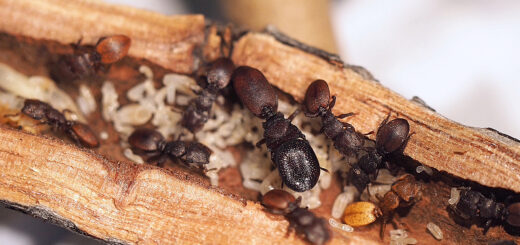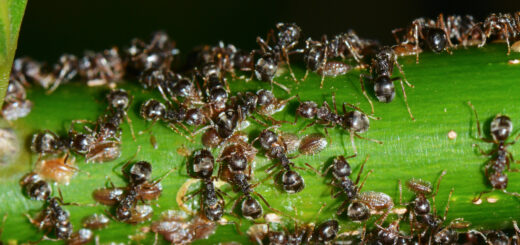Doing an ant PostDoc: Kaitlin M. Baudier
Kaitlin M. Baudier is a postdoctoral research associate at Arizona State University. She works on defense allocation and group on group aggression in a variety of social insects (including ants
An interview compiled by Roberta Gibson

MNB: Could you tell us a bit about yourself?
KMB: I am a postdoctoral research associate in the Social Insect Research Group of the School of Life Sciences at Arizona State University. I am affiliated with the labs of Jennifer Fewell, Ted Pavlic, and Stephen Pratt. My research interests include social insect behavior, thermal physiology, and ecology.
MNB: And could you tell us about your research?
KMB: I am currently working in two general research areas: 1. task allocation in social insect defence, 2. geographic variation in ant thermal adaptation.
A little over a year ago, I joined a team at the Arizona State University (ASU) interested in the strategies social insect colonies use to defend against attacks from other groups of social insects. Our big goal is to use this information to help solve social problems in other areas (robotics, social media, etc.), but we also found out a bunch of new things about social insect defensive behavior as part of this
I have also used army ants (subfamily Dorylinae) as models to study how size polymorphism in social insect workers relates to the evolution of group thermal tolerance. As part of this project, I found out that heat tolerance often varies across differently-sized workers within the same ant colony, but how well size predicts tolerance really depends on the types of microclimates ants are adapted to (Baudier & al. 2015). It turns out that knowing something about an ant’s microhabitat is also very important to accurately predict the relationship between elevation and thermal tolerance (Baudier & al. 2018b). This is not only a neat ant-ecology trend, but can also be used to improve the accuracy of large-scale climate change predictions for a variety of ectotherm species. We also generated a body of theory based on these data that suggests that thermal tolerance may evolve differently in eusocial species, due to indirect fitness (Baudier & O’donnell 2017).
Another army ant project of mine has been to study if and how army ant bivouacs (temporary living nests made out of thousands of live ant bodies) thermoregulate themselves. To get a better picture of how army ants respond to both extreme cold and heat, we studied army ant thermoregulation both at the tops of mountains and in low elevation sites in Costa Rica. It turns out that bivouacs of the army ant Eciton burchellii actually go through phases of relative thermoconformation where ambient temperatures are low (high elevations) and depending on the age of the colony’s synchronous brood (Baudier & al. 2018a). We even got super lucky and caught a rare glimpse of how high-elevation, subterranean bivouacs of Labidus praedator thermoregulate (Baudier & O’donnell 2016).

MNB: Oh wow, that is so interesting. And how did you end up studying ants?
KMB: My first experience in ant research was as an undergraduate at Louisiana State University, in the lab of Linda Hooper-Bui. Like many myrmecologists I started out as a lowly ant-counter, but for a series of cool diversity and disturbance projects. I began to slowly make myself more useful by learning to separate out and identify more and more species. I also began spending a lot of time drawing the ants I was looking at under the scope. This helped me gain identification skills quickly and remains something I do to this day.
MNB: That sounds like a good idea to learn identifying ants. And what is your motivation for doing ant research now? What do you enjoy most about ant research?
KMB: I enjoy experimental design for very similar reasons as I enjoy drawing. Both require equal heaps of creativity and observation. There is seldom a day when I am bored by my job, whether I’m visualizing a data set for the first time or even just counting ants (which I still do from time to time). No matter what the task, there’s always something new and surprising, some cool question waiting around the bend. It feels a bit like an adventure. So, I guess my honest motivation for doing research is that I find it fun.
MNB: Which is great! What was the biggest obstacle you had to overcome in ant research?
KMB: A lot of my research has involved army ants, a notoriously nomadic group unable to be reared in the lab. So, in order to do in-depth studies of their thermal ecology I’ve had to carry equipment in backpacks up and down mountainsides, and set-up makeshift labs everywhere from garages, to a cafeteria, to the exterior side of a building (anywhere there were outlets and a flat surface). It also means that, as a consequence of sticking temperature and humidity probes in bivouacs for several years, I have been stung perhaps more than the average myrmecologist. I found that the best way to reduce army ant stings while doing this kind of work was to wear tight-fitting but easily removable protective layers. Baggy clothing can drag across surfaces and irritate the ants more. Since army ants will always find a way into whatever you put on, it’s an important safety measure to be able to quickly take off any protective attire. For these reasons, I found that the common practice of taping one part of my clothing to another or wearing a bee suit were both terrible choices. On the bright side, the nice part of having a challenging field methodology is that being scooped was not really a concern.

MNB: Who or what inspired you to pursue a career in myrmecology?
KMB: Since I was a kid, I had always wanted to be a scientist, but it took getting into an ant lab to help me see the ways in which ants can be used as models to ask different kinds of questions. Taking the Organization for Tropical Studies’ Neotropical Social Insects Course in 2009 really gave me a sneak peek of the possibilities tropical ant research had to offer. It is also where I met Sean O’Donnell, who would later become my PhD advisor. His infectious excitement for tropical social insect research was quite inspiring.
MNB: Oh wow. And if you had not become a myrmecologist, what else would you have liked to become?
KMB: I toyed with the idea of majoring in literature early on in my undergraduate coursework. I have always enjoyed writing. Luckily, I get to do a fair amount of that as a myrmecologist.
MNB: So true. And during your research, have there been any funny moments?
KMB: In my first year of grad school I had a couple of field assistants who were truly great in every way. However, like many people who are in the field for the first time, they would occasionally startle at the sight of a scorpion under a mattress or the tracks of a puma. Because I didn’t share their reaction to these particular stimuli it became a running joke between the two of them that I was not able to be startled. I figured they would find out eventually that this was blatantly untrue, but I could not have predicted exactly how. One day the three of us set out to check on a bivouac up in one of our high elevation sites near dusk. I suppose I had put a small banana in my rain coat pocket that morning for a snack, but by then I had entirely forgotten about this now warm and rather pulverized pocket banana. We had finished what we were doing at the bivouac and I had turned around to head back downhill when I put my hand into my pocket and directly through the middle of the slushy warm banana. Somehow in the dim light, the feeling of the slimy hot peel clamping down on either side of my fingers registered as “my hand is in something’s mouth.” My reaction was, to put it simply, very startled. My field assistants watched in silence as I shouted and threw a soggy banana onto the trail. It became a running joke that although pumas and scorpions were fine, produce was my Achilles’ heel. Every time we passed a banana tree they would say “It’s okay, we’re here for you.”
MNB: That is really a funny moment. And what was the scariest moment?
KMB: There were a lot of reasonably scary moments. In search of ants, I’ve spent hours walking alone on trails in both the day and night. I’ve walked straight into a palm viper that looked very much like a vine. I even once found myself stumbling across the entrance of what seemed to be the den of a big cat. Still, even given that, I’d say the scariest moment for me was waiting to find out if I had been accepted into the PhD program at Drexel University. I was working full time in an entomology museum at that point (the Audubon Insectarium in New Orleans). The job was pretty nice, but it didn’t involve any research, and I was feeling as though I was lacking that creative outlet. I didn’t approach grad school applications in the way most do. I had only applied to that one program, nowhere else. Luckily, I was offered a position within a few days of interviewing, ending the period of intense nail biting.
MNB: Oh wow. And what was the most irritating moment?
KMB: About this time last year I began my first foray into bee research. We used the stingless bee Tetragonisca
MNB: And what was the moment you enjoyed most?
KMB: This is a tough one. There are so many good moments that just can’t be ranked. I’d say for most projects, there’s that turning point when “this might be interesting” becomes (or sometimes doesn’t become) “how interesting!” I really enjoy that feeling. It’s especially nice when I can get to that point in a field season with a few days to spare. It’s like suddenly backpacks get lighter, trails seem too short, and my blinders guiding me to perform the tasks at hand have been lifted. It’s a good feeling.
MNB: I believe many readers can relate to that feeling. Is there any particular situation in which you typically have the crucial idea for solving a difficult problem?
KMB: It’s amazing what can be done with a simple set of tools and household materials in a pinch. For all of the amazing high-tech approaches we have at our disposal these days, I am actually most proud of my low-tech solutions.
MNB: What are the main differences regarding research when you started as a myrmecologist compared with today?
KMB: I think genetics, genomics, and transcriptomics have probably changed the most between when I was an undergraduate and today. Thus, many
MNB: And do you have any suggestion for myrmecology newbies?
KMB: If you don’t already, spend some time in the natural environment of your model species. It’s part of why they are the way they are.

MNB: Slightly different topic now. The higher the career level, the fewer women, also in ant research – what do you think will be most important for achieving gender equality in this respect?
KMB: This is a very difficult question. One very important step we should be taking is to make more safe places for conversations about sexism and harassment. We need to increase the volume of women’s voices on the matter if we are to have any hope of solving problems faced by women.
MNB: So true. What would you do differently if you could start all over again?
KMB: I’m happy where I am now, so I don’t regret the path I’ve taken to get here.
MNB: What question are you asked most often when people hear you work with ants?
KMB: “Can you tell me what kind of ants are in my sink?”
MNB: What is the one thing you wish everyone knew about ants?
KMB: It’s worth taking a closer look. It’s amazing how much goes on every day right under our noses!
MNB: Do you have a favorite morphological structure / myrmecological phenomenon?
KMB: Antenna.
MNB: Do you have a favorite ant species?
KMB: If I had to pick one it would probably be Neivamyrmex macrodentatus. It was tremendously exciting seeing them in our underground bait traps. They are miniscule, and very sensitive to heat, but they remain the only army ants I was ever able to keep in the lab for more than two weeks. They became our field lab mascots.
MNB: In another life, if you could be an ant, what ant species would that be?
KMB: I like to solitarily forage for a snack at night as much as the next Ectatomma.
MNB: What is the book on your bedside table?
KMB: King Solomon’s Ring by Konrad Lorenz & Sting of the Wild by Justin Schmidt
MNB: Watching sports or doing sports?
KMB: I am terrible at most sports, but in general I prefer doing to watching.
MNB: Listening to music or playing an instrument?
KMB: Both are nice, but there is something really special about creating music yourself.
MNB: Do you enjoy the evening or the morning?
KMB: I enjoy both.
MNB: Tea or coffee?
KMB: I enjoy a taste of either from time to time, but I’m not really someone who craves for caffeine.
MNB: Habit or change, what do you prefer?
KMB: Change
MNB: Cooking yourself or going out having dinner?
KMB: Cooking for myself, given enough time.
MNB: Aspirator or forceps?
KMB: Aspirator
MNB: Nest densities or pitfall traps, what do you prefer?
KMB: It depends on the question. I think both have their place, and I find them equally enjoyable.
MNB: Field work or lab?
KMB: Field

MNB: Pin or ethanol?
KMB: Ethanol for ease of transport & molecular work. Pin for morphological identification.
MNB: Paper printed out or reading on the laptop?
KMB: I’d say 80% laptop. I try to reduce my paper waste, but I also really like to unplug when I am reviewing, or first diving into a new body of literature. In those cases, I’ll print and read in my hammock.
MNB: Journals financed by the author (open access) or by the reader (subscription based). What do you prefer?
KMB: I have my problem with both because I don’t think either gets to the root of the problem. I think the whole debate would benefit from an open and honest discussion of publisher profit margins, and whether there is a way to make the whole process cheaper, especially as we move to online-only. For now, I think it is good that both exist, so that readers without money can access at least some information, and so that scientists in financial hard times can at least publish somewhere. It’s still not ideal though.
MNB: Kin selection or group selection?
KMB: Multilevel selection
MNB: Do you prefer monodomy or supercoloniality?
KMB: Variety is the spice of life. That both exist is very useful for a future direction into which I’d like to move with my research.
MNB: Do you prefer the workers or the queens in an ant colony?
KMB: Workers, I suppose. I feel much worse about destructively sampling queens than workers… but mostly because I imagine the impact to workers’ indirect fitness after doing all of that work.
MNB: Thank you, for this nice interview. You have shown us that studying ants in the field is not for the squeamish or cowardly, as you revealed that you have faced army ant stings, scorpions, mountain lions, and of course, bananas.
References
Baudier, K.M., D’amelio, C.L., Sulger, E., O’connor, M.P. & O’donnell, S. 2018a: Plastic collective endothermy in a complex animal society (army ant bivouacs: Eciton burchellii parvispinum). – Ecography.
Baudier, K.M., D’amelio, C.L., Malhotra, R., O’connor, M.P. & O’donnell, S. 2018b: Extreme Insolation: Climatic Variation Shapes the Evolution of Thermal Tolerance at Multiple Scales. – The American Naturalist 192: 347-359.
Baudier, K.M., Mudd, A.E., Erickson, S.C. &
Baudier, K.M. &
Baudier, K.M. & O’donnell, S. 2017: Weak links: how colonies counter the social costs of individual variation in thermal physiology. – Current Opinion in Insect Science 22: 85-91.
Ostwald, M.M., Ruzi, S.A. & Baudier, K.M. 2018: Ambush Predation of Stingless Bees (Tetragonisca






Recent Comments